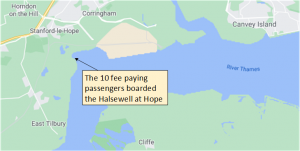Halsewell’s Voyages
The Coromandel coast of South-east India and the Bay of Bengal. Captain Peirce attempted a third journey to this location in 1786 but he unsuccessfully fought against the mighty elemental forces of nature, six days into this journey.
Halsewell’s First and Second Voyages
Captain Peirce had completed two other successful Halsewell journeys.
The first destination was the Coast and China. he ship left Gravesend 1 December 1778 and returned to the Downs 20 October 1781.
The second destination was the Coast and Bay, the ship left Gravesend 24 December 1782 and returned to the Downs 28 August 1784.
The Coast and Bay, is a reference to the Coromandel coast of South-east India and the Bay of Bengal. He attempted a third journey to this location in 1786 but he unsuccessfully fought against the mighty elemental forces of nature, six days into this journey.
Halsewell’s Third and Fateful Voyage
On the 16 November 1785 the Halsewell was hired by the Honourable East India Company (HEIC) to make her third voyage to the Coast and Bay. She was moored at Gravesend Kent, where she was loaded with provisions and cargo. She was loaded with a general cargo, the inventory was not recorded, but the following is an example of Company Trade 30.
Cloth of all kinds, with pleasant colours, Venice reds derived from ferric oxide, woollen cloth or garments made of it. Quick silver or mercury, drinking glasses, trenchers (wooden plates) for sweetmeats, mirrors, leatherware, particularly saddlery and the finest London made boots and shoes always provided a 100 % profit.
Also, this ship carried: bullion, Spanish silver reals; unmanufactured metals; cutlery, ironmongery, locks, bolts, scales and weights, clocks and watches, lead and copper sheets, copper pumps, canvas cordage and marine stores.
The Private Trade, an allocation of cargo space for each HEIC officer. For example, a Captain was allowed 56 tons and the First Mate eight tons, if the captain was unable to acquire 56 tons of goods he could make up the deficit with bullion up to the value of £3,000 – in the case of the First Mate £300 31. The bullion would be in the International Currency of the time the Spanish silver real, there were eight reals to the Spanish dollar, although, this currency was not an acceptable currency in India and from 1717 the East India Company established their own mint in Bombay where they minted a silver Rupee with inscriptions detailing the name of the current Mughal emperor, in line with Islamic tradition 33.
There was a report by the London Recorder & Sunday Gazette on 15 January 1786, where they state that Captain Peirce, who was destined to retire on his return, had made a significant investment in his allocation. In particular, fashion that was much sought after by the European high society’s desire for expensive high fashion clothing and other accoutrements 29.
After leaving Gravesend, with a compliment of 50 crew members, 108 soldiers, two soldiers’ wives and a new Thames Pilot 34. Haswell travelled down to the Hope were she boarded fee paying passengers, they were: Captain Peirce’s two daughters Eliza (aged 16) and Mary Ann (aged 14) – who were going to be married to gentlemen of fortune; two of the Captain’s nieces – Amy and Mary Paul; the daughters of Mr Paul of Somerset; Miss Elizabeth Blackburne – the daughter of Captain Blackburne a commander in the service of the HEIC; the two Miss Templers of Bedford Square – who were the sisters of Halsewell’s Acting Mid shipman Charles B. Templer and two other woman – Miss Mary Haggard and a Miss Ann Mansell. The only male passenger was Mr John G Schultz who had acquired a large fortune in Asia and was returning to Indostan (Hindustan) to collect an outstanding debt 27.
The Hope, is a creek situated north of Thames River mouth in the Parish of Standford-le-Hope, this area would be more genteel than the squalor and pestilence prevalent in the east end of London.
On the 1st January 1786, after loading the passengers Halsewell sailed through the Downs, a seaway off Deal on the east coast of Kent 27 to the next point of call on the north-east coast of the Isle of Wight, called the Mother Bank where the ship would be anchored and the decks would be scrubbed for the senior HEIC representatives. Here three directors of the company (HEIC) would come aboard to survey the ship, they would be greeted with a customary 13-gun salute that would be repeated when the left. The escort ship Honourable Company Ship (HCS) Ganges joined Halsewell at this point to form a convoy.
On previous voyages, contingents of troops were boarded at this location.
They set sail for Madera on Monday the 2nd January 1786, the weather was calm in the morning but when they attempted to land the Pilot, at 3 pm, a southernly breeze sprung up a forcing the ship to anchor at the western entrance to the Solent, in 18 fathoms of water at 9 pm , with the Pilot still aboard. At this point heavy snow was falling and they were unable to gather in the lower sails, because of ice making the sail inflexible 29.
